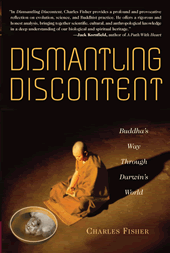 |
|
Bhikkus, both formerly and now what I teach is suffering and the cessation of suffering. Nothing is easier than to admit in words the truth of the universal struggle for life, or more difficult…than constantly to bear in mind. |
An Excerpt from Chapter One
Silently the sun moves to the west over a frozen marsh on a warm February day in New England. I emerge from the meditation hall during a retreat and hike over the icy, crusted snow down the sloping landscape, across frozen cornfields and through the woods to a marsh about a half a mile wide and a mile long. My footsteps encounter many different textures. Sometimes my insulated boot crashes through the crust, sometimes just my heel. Occasionally I fall when my foot slides out from under me.
Moving slowly and quietly as I near the marsh, I see a tetragnathid spider climbing an invisible thread toward a dead twig. Its body measures half an inch with long front legs. It seems to sense my presence as I push my myopic eyes close to it. When it reaches the twig, it hunkers down. Its dark body is invisible against the gray bark. As I near the marsh, I am greeted by fallen trees and standing, dead trees ringed with tooth marks. On the marsh, the smooth ice is punctuated by crusts of snow, tufts of grass and deer prints frozen from warmer days.
The marsh has a long history. Born as a stream at the end of the last ice age, it supported generations of beavers and their works until the coming of the Europeans. Then the beavers were hunted to extinction. The stream was dammed for power to mill grain and lumber. The marsh was drained to make fertile fields and abandoned in the nineteenth century after only several generations’ use. Years later, the marsh was preserved by the Audubon Society. Around 1986, beavers returned and rebuilt their dam. The beavers multiplied and felled the surrounding trees until there were no more close by they could safely harvest. So the beavers moved on. Without their continual maintenance, the dam was breached and the pond began to silt in. After two hundred years of disrupted succession, the marsh is gradually becoming a meadow; someday it will be a wooded stream for the beavers to re-inhabit as if human interruption had never occurred.
The human mind evolved to its present form during the ice ages. Before human ancestors had speech and complex thought, they may have lived in a mental quiet closer to that of the beavers than we now experience in the hustle and bustle of modern daily life. As the mind evolved, humans were able to create technologies eventually used by both Native Americans and Europeans to drive the resident beavers and Natives almost to extinction. Then active minds and the work of hands farmed the soil to exhaustion, mined the water and moved on. Years later, other busy minds began to manage the marsh as habitat for beavers.
Calmed by the tranquility of the retreat and buttressed by hours of meditating next to the marsh, I can feel the stillness in contrast to the incessant chatter in my head. I sleep for a while on a rock in the warm winter sun. On waking, the sun has advanced towards the trees on the opposite shore. For a moment I am awed by the silence and inevitability of nature. Then I begin to think again. Words to write come pouring out. I feel an urgency to be on time for the evening sitting in the meditation hall, and the problems of my life again possess me.
How did this mind so filled with thoughts come into being? What is its relationship to the body? With any self-examination it is not hard to see that these two are interwoven, much as we might like it otherwise. Personally, if my body behaved itself without bothering me, if my mind would shut up and my emotions calm down, I might be a lot happier. I want to exercise with abandon, eat to excess, be lazy, enjoy the senses, wake rested and be nurtured and deeply touched by connection to others. Unfortunately, except for a period of apparent indestructibility in youth, the human body experiences problems which intrude into happiness. And even during youth, our feelings and thoughts create one problem after another.
In addition to our personal problems, if we look at the world around us, we see many troubling things. There is disturbing population growth, environmental degradation, a world of haves and have-nots and among those with material security, a concern with consumption and entertainment that seems out of balance with the problems in their own lives and the rest of humanity.
Twenty-five hundred years ago, Gautama Buddha investigated human nature using the tools he had at hand. These involved an examination of his own mind and body through meditation. Buddha discovered what he claimed was universal human discontent. For discontent is the norm. The human mind does not often rest peacefully in the bosom of life. It is plagued with restlessness, greed, dissatisfaction, laziness, fear and anger. Occasionally humans rise to peaks of love, generosity, equanimity and compassion, but mostly they struggle in the valley of discontent. This is true even in the best of times.
The Buddha discovered the causes of discontent by becoming still and carefully observing how human experience unfolds. He saw how deeply entwined are the mind and the body, how much the human mind reacts to stimuli impinging upon it, and how much we are affected by our web of relationships with other people. The Buddha’s method of observation was meditation, and for thousands of years meditators have emulated the Buddha’s example. In so doing, they have found a greater understanding of who they are, and how the responses of their minds affect themselves and others around them…
